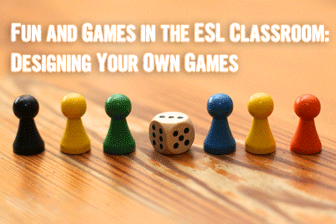Using Traditional Games with Language Learners


Almost everyone likes games. They are fun, energize the players and require their players to use imagination and brain power. What is there not to like when it comes to games? Games can provide an additional benefit to the ESL teacher – they can give your students practice using their English skills. With this unit on making games, your students will walk through the process of creating and producing their original games as they use their English along the way.

Game Research
Before your students can create their original games, they will need to do some research on what kinds of board games people like and what is already available. If possible, take your students to a toy store and let them peruse the aisle that houses board games. Each person should write down the names of the games that are available for purchase. If there is not a toy store nearby, take your students to a large department store. Target, Wal-Mart and other department stores usually have a toy section and within that section a shelf or two of board games. As your students are writing down the names of the games available for purchase, encourage each person to read the information that the box offers. They may be able to determine the overall concept of the game as well as the rules and objectives. The goal of the activity is to get a general sense of what each game is and how to play it.
An Original Idea
Now that your students have some exposure to what games already exist, it is time for them to start using their own imagination. First, each person should determine whether he wants to design a game of chance or a game of skill. Looking back on the list that each person made in step one, the games there can be classified into either games of chance or skill. A game of chance depends on your ability to roll well or choose good cards during play. These types of games include Chutes and Ladders and Candyland. Other games require skill or strategy from the players. This type of game includes Monopoly and Jenga. With skill games, the decisions that players make determine the outcome of the game.
Once your students have decided on a game of chance or a game of skill, they should start thinking of the overall concept of the game. Will players imagine themselves in a post apocalyptic world of zombies or will they role-play bunny rabbits making their den. This is where your student’s personality will really come out in his game. Once the overall concept of the game is determined, your students should decide what the goal of the game will be. Will it be to kill all the zombies or create the most harmonic rabbit den? The final goal should fit with the overall story.
How to Play
Now that each person has his overall concept and final goal, it is time to decide how to get from point A to point B. Will players travel along a game board, rolling dice as they go? Will they have to answer questions and get clues to the mystery that they must solve? Have your class use the games that they listed in the first step as inspiration for their original game. After deciding how progress will be made, your students should determine what rules the players must follow as they move throughout the game. Here is another place to gain inspiration from games that are already in production. In general, the fewer rules a game has the easier it will be to play and, perhaps, the more appealing to its players. Have your students try to compose three to four rules that players should follow while playing their games.
Making it Happen
The final step is where creativity meets practicality. Your students must now produce the games they designed. First, each person should physically create his or her game. You will want to have as many resources available to your students as possible at this point. Some may need computers to produce cards for their game play. Others may need dice or props. Many will need large pieces of cardboard that can be made into game boards. Have each person determine what he needs to make his game and then do whatever it takes to make it happen.
The second element for making the game happen is to write a set of instructions for players to follow when playing the game. If you have any games in your classroom or at home, let your students read the instructions that came with the game. These are often in a booklet or printed on the inside lid of the game box. You can also find directions for playing games online, and you can allow your students to read these instructions and use them as models as they write their own instructions. Each person should type up his instructions once they are written and package them with the other elements that he created for his game. Now all that is left to do is play the game!
Play Time
You may want to spread this activity out over several days to avoid burnout on the part of your students. Group your class into teams of four. Each team will then play a game created and produced by another member of the class. The creator should not be a participant in the game but should be an observer of the group as they play. The group will need to follow the instructions that the creator wrote. The game creator should watch to see how well his classmates are able to play his game, how clear his instructions were and how much fun the group seems to be having. If the group gets stuck, he should step in and help. Once all the games have been played, each person should write an evaluation of his game. He should note how well his classmates were able to play and how much they seemed to enjoy the game as well as any modifications he thinks should be made.
With reading, writing and speaking in the mix, your students will use many of their language skills over the course of this unit and will finish with an originally and (hopefully) entertaining game!